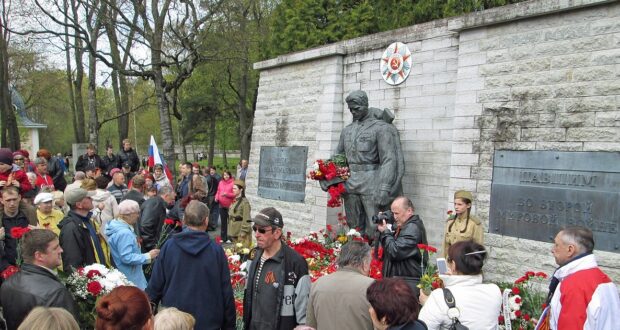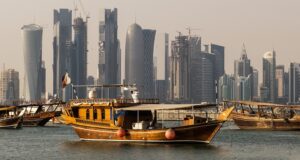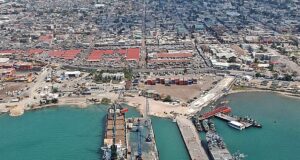20 November, 2020
by Hamish Cruickshank – Research Assistant
In February this year, I travelled to Latvia to visit one of my friends who was working at the Dutch Embassy in Riga. The city was picturesque, the local people were lovely, and to me Riga felt truly European. However, the clashes of Art Nouveau with Soviet Brutalism and the considerable Russian diaspora in the city – roughly 37% of Riga’s 630,000 population are ethnically Russian – provided a striking reminder of Latvia’s Soviet past and of the country’s close proximity to Russia.
Latvia gained independence from the Soviet Union in September 1991 along with Lithuania and Estonia, and the three Baltic States became fully fledged members of the EU and NATO in 2004. In spite of this, these states have long been targeted by Moscow in a bid to constrain their independence and influence and undermine their political and economic choices. Given their relatively small size, geographic location and their historic reliance on Russian energy, the Baltic States have been susceptible to Russian influence in the past and this has proven to be a thorn in the paw for the Governments in Tallinn, Riga and Vilnius. Despite this, the Baltic States have become more adapt at countering this malign influence and have made impressive progress in recent years with regards to fighting disinformation and reducing their energy dependence on Russia.
Russian Objectives in the Baltics
While the independence of the Baltic States is not questioned, they tend to be viewed as ‘former provinces’ by Moscow and the Kremlin has sought to keep them tied into the Russian sphere of influence like most of the other former Soviet Republics. While Latvia, Estonia and Lithuania have sought to pull themselves out of Russia’s orbit and entrench themselves as Western, European states, Moscow has sought to influence and destabilise this process. The accession of the Baltic States into NATO and the EU in 2004 gave many hope that Russia’s ability and desire to influence these states would greatly diminish. However, the past couple of decades has shown us that Moscow still strives to maintain a “zone of privileged interest” in the region.
Consequently, Moscow has a number of clear policy goals with regards to the Baltic States:
- The Kremlin seeks to keep the Baltic States politically, economically and socially tied to Russia and alter their strategic direction.
- Moscow aims to acquire or utilise key infrastructure in the Baltics and also limit the deployment of NATO units and weaponry in the region.
- With roughly 1 million ethnic Russians living in the Baltics, the Kremlin has pushed for better treatment of Russian minorities and lower barriers for Estonian and Latvian citizenship.
- Moscow also prioritises ‘protecting’ the historical narrative that cites the Soviet Union as the liberators of Europe from Nazism. This narrative has been widely denounced in recent years by Eastern European states who see the Soviet victory in 1945 as the beginning of the brutal Soviet occupation of Eastern Europe.
Hard Power and Soft Power
To facilitate its Baltic policy goals, Moscow has employed a mix of hard power and soft power. Hard power refers to ‘a nation or political body’s ability to use economic incentives or military strength to influence other actors’ behaviours’, while according to Joseph Nye, “soft power is the ability to attract based on a state’s culture, political values and foreign policy”’.
Moscow’s use of hard power in the Baltics has been most visible in the energy sector. A 2012 study found that all three states were around 90% dependent on Russian oil and nearly 100% dependent on Russian gas. Soviet-era energy infrastructure combined with a lack of domestic natural resources meant that the Baltics were forced to turn to their Eastern neighbour for oil and gas, and Moscow has often taken advantage of this situation. Oil sanctions, energy disruptions and the dissuasion of foreign firms from collaborating with Baltic energy projects have all been utilised to further Russian interests in the region. For example, in 2006 Russia halted oil supplies to the Lithuanian oil refinery Mažeiku Nafta (MN) in response to the Lithuanian Government’s decision to transfer ownership of the refinery to Poland’s PKN Orlen in May 2006 instead of to the Kremlin-linked Lukoil.
Another example came in 2007, when the Government in Tallinn voted in favour of relocating a Soviet memorial from the city centre to a military cemetery on the city’s outskirts. The memorial represented Soviet glory for Moscow and was a stark reminder of the Soviet occupation for Estonia. The move was met by Russia halting rail deliveries of crude oil and gasoline. The oil embargo was also accompanied by riots in Tallinn involving roughly 1,500 local Russians that were widely believed to have been organised by Moscow and cyber-attacks on Estonian Government, financial and media computer systems. From 27 April, these ‘distributed denial of service’ attacks disrupted online banking, wreaked havoc with governmental communications and prevented media outlets from delivering the news. Cyber-attacks have become an important foreign policy instrument of the Kremlin in the 21st century and the Baltic States have experienced numerous other cyber-attacks believed to have been launched by Russia, such as in 2015 and 2017.
With regards to soft power, Moscow has historically sought to influence Baltic policy making through a number of different means. For a start, Moscow has sought to cultivate Kremlin-friendly networks in the Baltics that hold influence in the political, economic and cultural sectors. Political and business elites have been co-opted via financial incentives or bribes into furthering Russian interests and influencing the political process. Emily Ferris contends that Russia maintains a “significant influence in the Baltic business community, particularly in Latvia and Estonia” and states that Russian interests dominate the business and banking sectors.
Additionally, Russia’s compatriots policy has been seen as another means of furthering Kremlin influence in the Baltics. The policy offers automatic Russian citizenship to anyone of Russian descent and also offers these ‘compatriots’ Russian protection. Putin has repeatedly complained about the “major violations of human rights” of ethnic Russians in the Baltic States, as many ethnic Russians are technically stateless, and has promised Russian support for these peoples. Given the considerable Russian diaspora in the Baltics, the initiative has raised serious concerns and the Latvian National Security Concept has labelled the policy “an instrument for the involvement of compatriots … (to) influence the activities of Russia which are directed against the national security of Latvia.”
Finally, through propagating the compatriots policy, Moscow has also attempted to cultivate a receptive audience for its disinformation efforts in the Baltics. Since the early 2010s, the Kremlin has intensified its efforts to spread disinformation and propaganda via Russian-funded media outlets and via social media. Media channels such as Sputnik or Channel One Russia pump Russian disinformation into the Baltics. This disinformation has ranged from stories accusing NATO troops of spreading the corona virus in the Baltics, to the rape of a fabricated Lithuanian orphan by German NATO troops, to Lithuanian ambitions to seize Kaliningrad. While the effectiveness of this disinformation in the region is disputed, its prevalence is not, and is indicative of Moscow’s ambitions to sow suspicion in Baltic society and promote the Kremlin world-view in Russia’s near-abroad.
How the Baltics have Countered Russian Influence
The Latvian National Security Concept, the Lithuanian National Security Strategy and the Estonian National Security Concept all make clear that Russia is still the biggest threat to Baltic security. Russian efforts to influence Baltic society are mentioned frequently and each paper makes clear that Moscow is a serious destabilising force in the region.
In spite of this, the Baltic States have made impressive progress over the past decade in countering Russian influence in the region. Regarding energy, while Latvia, Lithuania and Estonia all still buy Russian gas, the three states have attempted to diversify their energy supply and have built new infrastructure in a bid to tap into European energy networks. The EU’s 2009 Third Energy Package required member states to ‘unbundle’ their gas markets – splitting energy supply from energy transmission – and ensure fair market competition and fair market prices. Estonia and Lithuania unbundled by 2012, with Lithuania following in 2017 and this has disrupted Russia’s stake in the Baltic energy markets. Furthermore, in 2014 Lithuania opened a new LNG terminal and increased gas imports from Norway and in 2020 Estonia and Finland finished work on the ‘Balticconnector’, a gas pipeline that connects Estonian and Finish gas grids. Given the existing infrastructure in the region, the pipeline will essentially connect Finland to the Baltic energy grids and provide the Baltic States with 7.2 million cubic metres of gas per day. Lithuania is also currently working with Poland on the Gas Interconnection Poland/Lithuania pipeline due to be completed in 2021.
The Baltic States have also become an example for the rest of the world in dealing with Russian cyber-attacks and disinformation efforts. In 2008, NATO’s ‘Cooperative Cyber Defense Center of Excellence’ was opened in Tallinn and in 2010 Estonia founded the ‘Cyber Defense League’ in a bid to shore up the country’s cyber defences. In Riga, NATO’s ‘Strategic Communications Center of Excellence’ was established in 2014 to detect and monitor Russian disinformation efforts, while the Lithuanian-founded ‘Baltic Elves’ monitor and combat Russian disinformation and propaganda.
Finally, NATO’s ‘Enhanced Forward Presence’ (EFP) has made a real difference to Baltic security. Following the Russian occupation of Crimea and invasion of Ukraine, NATO members agreed at the 2016 Warsaw Summit to deploy four multinational battalions to Poland and the three Baltic States. These battalions are made up of troops from 19 of the 29 NATO member states and act as a ‘tripwire’ deterrent to any potential Russian invasion. While Donald Trump has moaned about NATO member states failing to meet the required 2% spend of GDP on defence, the Baltic States all meet this target and this is a clear indication of the value they put on NATO’s protection in the region.
In sum, while Russia still seeks to exert its influence in the Baltics, Latvia, Lithuania and Estonia have made fantastic progress with regards to diminishing the Kremlin’s influence on the region. Russia will remain a destabilising force in the Baltics for the foreseeable future, but energy diversification, efforts against cyber and propaganda offensives and an enhanced NATO presence have done much to counter Russian influence in the region and pull the Baltic States further away from Russia’s orbit.
Image: The Bronze Soldier of Tallinn monument to Soviet WW2 soldiers, the relocation of which triggered Russian reprisals in 2007 (Source: Liilia Moroz via CC BY-SA 4.0)
 Human Security Centre Human Rights and International Security Research
Human Security Centre Human Rights and International Security Research




